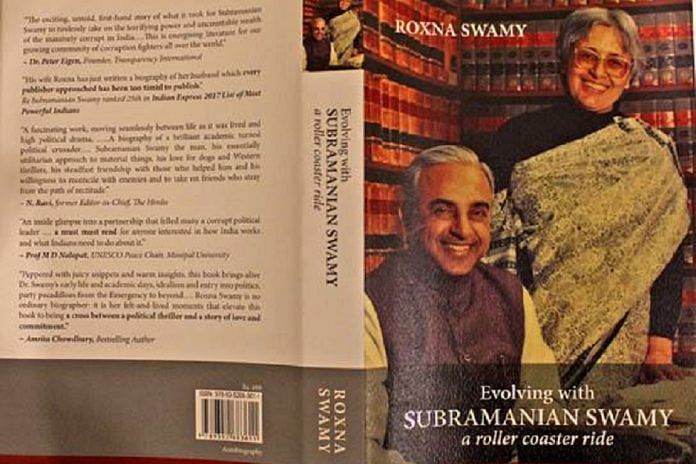The reader doesn’t come away with a deep understanding of the man who likes to create a tempest wherever he goes.
‘Evolving with Subramanian Swamy: a roller coaster ride’, by Roxna Subramanian Swamy, is meant to create empathy and understanding for one of the most brilliant, non-conformist and polarising politicians of modern India.
That it would be a sympathetic portrayal of the un-censorable Swamy was expected. What comes as a surprise is how unapologetically one-sided it is. The author, his wife, paints him on a canvas of victimhood, as a man who is an eternal outsider, wronged and misunderstood.
The wronged man, a pedigreed “Madrasi Brahmin” (“bloodlines are pure Iyer Brahmin”) comes from a land-owning family, studied at DPS Mathura Road, graduated from Hindu College, joined the Indian Statistical Services, studied and taught at Harvard – not exactly the kind of protagonist who is an unfortunate, underprivileged man.
Dedicating the book to “Swamy’s admirers”, the very first page says the self-published book was written because the media is not a faithful chronicler. Then she calls “secularism” a dirty word, and says her Parsi civil servant father had “contempt” for former Prime Minister Jawaharlal Nehru.
And the book hasn’t even begun!
Swamy is known today as an in-your-face Hindutva mascot, king of scandalous exposes, and an arch Nehru-Gandhi clan foe. He rules the Twitter universe with his poison-tipped tweets and his dartboard is almost never without a pinned face. A one-man army, he has successfully brought down reputations and governments.
He evokes enormous curiosity, fear, anger, but rarely any sympathy.
But if you are looking for a glimpse into the inner workings of the mind of Swamy, this is not the book.
Whether it was letting the inspectors know that his school principal was siphoning money, or later stopping Indira Gandhi’s Italian daughter-in-law Sonia Gandhi from running an insurance agency from the official residence – Swamy has always been unstoppable.
It is this aspect of his personality that requires forensic scrutiny. And that is what is missing in the book. You don’t come away with a deep understanding of the man who likes to create a tempest wherever he goes.
We learn that Swamy counselled Jayaprakash Narayan on how to counter the “Congress rot”, that his paper on how to develop an affordable atom bomb and delivery system impressed the Jana Sangh, how he called for a Hindu renaissance, and prepared a swadeshi alternative to socialism which made Indira Gandhi call him “Santa Claus” in Parliament.
But Swamy was friendless, the author wants to convey. When he was dismissed from his IIT job, the Delhi elite distanced itself from him, stopped inviting him to seminars and parties, and treated him like a “non-person”. She blames the clubby resentment toward “a Madrasi who probably ate with his fingers”, who was not “entitled to consort with them in their rarified forks-and-knives eyrie in the IIC” – all of which added up to a “Swamy blackout”. At that time, it looked like “there was to be no place in India for a self-respecting intellectual like Swamy”.
So how did Swamy break out of this Delhi blackout? It was all thanks to Twitter and television debates. Twitter was a marvellous way to keep in touch with a “brave new open-minded world”.
But in politics, even his natural allies in the Jana Sangh refused to help him, the book says. The party’s parliamentary leader, Atal Bihari Vajpayee, said Swamy had indulged in corruption by claiming a few hundred rupees for attending Parliament when he hadn’t. The author says Swamy claimed the money because he had travelled to Delhi “with the intention of attending Parliament”, which was what was legally required.
That set in motion several decades of isolation for Swamy. The incident is a good peg to understand how Swamy helped bring down Vajpayee’s government in 1999 in a dish served very cold.
Roxna Swamy is an accomplished professional, with two advanced degrees from Harvard and IIT Delhi. She was the lawyer for Namgyal Dolkar, the first Tibetan born in India to have been granted citizenship. She was also one of the lead lawyers in the landmark case that secured the right for minorities to run their own educational institutions. But what comes through in this book is the author-wife’s devotion for Swamy and tigress-like protectiveness.
She is upset that a media critic once dismissed his views as “boring”. She bristles at the word. He can be called “communal, biased, right wing, slanted, downright evil,” but not “boring”, she writes.
To know such a man, “the Essential Swamy” book is still awaited.




We all know the print is funded by Rotten Tata.
Dr.swamy and rotten Tata had clashes so it is not amusing that print media gave harsh critique about this book.
Really media is unreliable these days .
Gone are the days of Shri. Ramnath Goenka.
Dr.Swamy is a lion and always had the courage,intelligence to support the truth.
We are lucky to have such practical educated intellectual politician among us.
Subramanium Swamy, also known as ‘Su Su Swamy’ among netizens is a living embodiment of the phrase, “Public nuisance”.
Be happy with this old news of china led world bank, AIIB. The third annual Asian Infrastructure Investment Bank (AIIB) summit was held in Mumbai on 25-26 June, 2018. In a span of three years, the AIIB has done a commendable job, with the value of approved projects being around $4.4 billion, one-third of which have been granted to India alone.
Its understood that the book is one sided as it’s written by Dr Swamy’s wife and is for his sympathisers..
But why is this piece one sided..considering it’s written by a “journalist”…One can only guess but never really know…
Proves Roxna Swamy yet again Right about snakes and elites and Media..